Best of Reaktor User Library December 2007
Effects
Native Yardstick v1.1
By Guenther Fleischmann
![]()
A native version of the Quantec Yardstick
Important: This version works only with 44.1kHz Samplerate. Otherwise you get some bad feedback. A new version is in development.
"Is the sound of this ensemble just similar, or is it more?" you will ask.
Well, i analyzed (optically) some authentic impulse respones of the Quantec Yardstick 2402 from echochamber.ch. After looking a while on it, i found out how this device works.
In total there are 48 different delay lengths. If Roomsize is at 100000m³ the delaylengths are SAMPLEACCURATE compared to the original. The amplitude of each generated impulse equals at least 97% with the value of the original. The other 3% may be the result of some inaccurateness concerning EXP-Functions within DSPs.
So, i can say that the basic character of the Yardstick can be reproduced with this ensemble!
Anyway there are some deviations from the original:
- The internal parameters for Rt-Low and Rt-High are unknown to me. I choosed values which work well.
- The way how stereophonic signals are processed is also unknown to me. I did it in a way which is conformable with the basic algorithm.
- The Brickwallfilter on the original is 15 samples long, in my ensemble it is 29 samples long (better performance).
There is a feature which cannot be found on the original - it's the ROOMSIZE Parameter. When you turn this knob all 48 Delays inside are compressed or extended at the same time.
Some of you will call for the possibility of modulating the reverb tail. Because of the nature of the QRS-Algorithm this is not possible. The delaynetwork inside would get instable immediately. On the other side this is one of the reasons why the QRS-Algorithm is rocksolid concerning pitch.
Some people may complain about CPU-Load; I've a solution for them: Go and buy the hardware original and pay several thousand Euros... ;-)
P.S.: In the ZIP-File you'll find two Ensembles. The second is the Yardstick without the Freezing Feature, which helps to save CPU-Load a little bit.
***
Samplers
Colorstrip v1.0
By sonictwist !
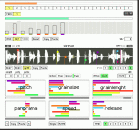
A loopslicing, recycling, destructing and what not tool.
-Eight clolours represent eight sample slices. You can set the start positions for each slice individualy just by moving colour dots on the sampler's window.
-Each slice got many settings, wich you can adjust using the parameter cells below the sampler.
-Slicesequencer on the upper side of the instrument to control the sequence of these slices.
-Scenesequencer to control the sequence of the internal snapshots (8 scenes), thus you are able to make a really long arrangements.
-A special autostretch feature will keep your loops synced to the host's tempo.
-A flexible "buffer exchange" system wich allows you to copy/paste almost any parameter between scenes and presets.
and so on...
***
Sequencers
Drum Sequencer (for Battery) v1.2
By Oliver Greschke
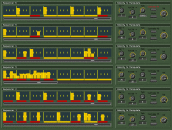
Drumsequencer for Battery or other Drummodules
I like NI Battery, because you can work very fast with it, but drumprogramming in Cubase/(Ableton) is boring and uninspiring.
Therefore I want to built a Sequencer which is specialized for Drums and has some random functions for inspiration and fun.
This tool is not much more than a modification of Massive of Reaktor 5 Library, which I like very much. My programming skills are not too great but I think this Ensemble could be worth to share with others, especially people who work with battery or some other external drum tools.
So, as I said, most of the technology is from the Massive ensemle, what I added is some midi functionality to control external stuff.
***
patgen v1.0
By Florian Erdle

pattern generator
checked out my old reaktor ensembles and found this little tool i build in 2004.
***
Terminal Glitch 2 v1.0
By Dean Lowe

4 Track Percussion/Melody Sequencer
Here it is! (finally)
I've uploaded this as a new file as this isn't designed to replace version 1. Think of Terminal Glitch 1 as a lite version.
New Features
-You can now select between the standard Oscillators or the new WaveTables.
-Each Osc has a Saturation stage in the Filter section, with a variety of flavours.
-Modulation has been completely rewired now with 36 destinations (including the Attack and Decay times for each OSC). Press the Modulation button in the Global section to view the options.
-Frequency Shifter, Quantize and Sample Reduction added to the effects section.
-Master Filter now features four routing options.
-2 x LFO's with LFO1 x LFO2 and LFO1 - LFO2 selectable as modulation sources.
-Snapshots controllable via Midi CC or Midi Notes.
-A dedicated Wavetable editor in the 'B' view.
-Waveform display, particularly useful for viewing the result of LFO1 x LFO2.
-Improved GUI layout.
Credits go out the usual suspects, Rick Scott, Clist and Theologiae. There is a couple of people I forgot to mention the first time round. Mike Daliot and James Walker-Hall's 'Metaphysical' was a direct inspiration for the Automation Faders. Dieter Zobel's 'Skurrilia' was also a large inspiration for this instrument.
***
Specials
orgaNism teN v1.2
By rick scott
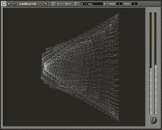
yet another orgaNism
still obsessed with creating living breathing musical organisms that make music on their own (with help from their humanoid companions). orgaNism teN is a strange and delicate beast. good for generating material, then editing down to expressive melodies and textures.
please read the instructions (popup) for mousepad usage.
***
Ten + Ten v1.0
By Jim Hurley
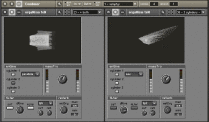
organism ten with guest
This is what happens when organism ten has a friend.
This is a fairly trivial combination of rick's organism 10 - basically a ring modulation with slew limiter on the outputs.
***
Synthesizers
ParaWahn3 v1.0
By Dieter Zobel
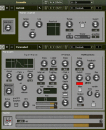
not a great innovation,
but i hope it's funny at a winter evening like this
***
Resistance Is Futile v2.0
By Jonathan Style
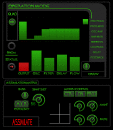
Skrewell Assimilated
I didn’t like the previous re-skin that did of Lazyfish’s Skrewell so I changed it. I kept the Star Trek theme. Hope it work for you all.
Nothing has been modified within the instrument. All your snaps will still continue to work. I only re-skinned it. Lazyfish’s original structure is still intact.
V.2 messed it up a bit with shapshot morphing. The "Bank" set Snap bank A/B,the "Snap Set" sets the snapshot, press "A" or "B" to load for snapshot morphing. Not that changing "A" will change the Snapshot. The Morph controls and X/Y (Amount and quick morph time), then two control to set the morph/time these can be accessed by "Prg1/2." Hope that makes sense.
***
